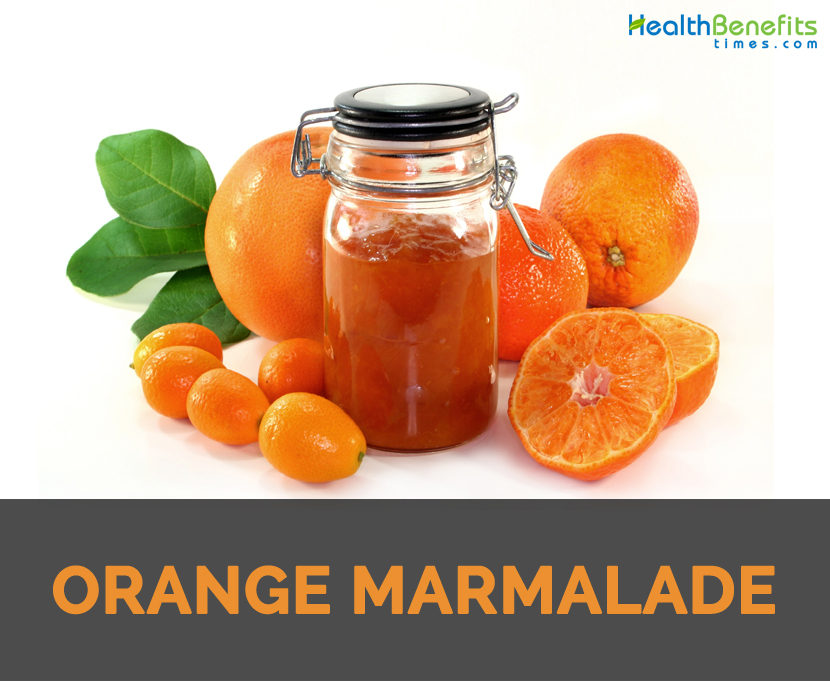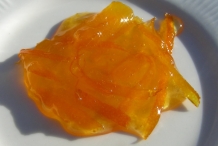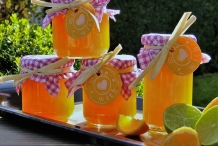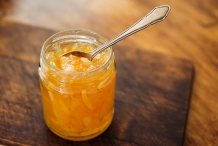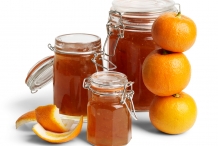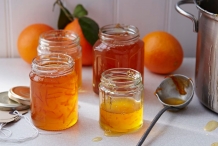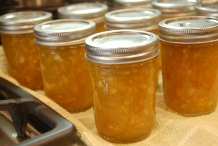Orange marmalade is a gel or semi-solid like product which is made from orange fruit ingredients together with more sweetening ingredients and contain suitable food acids, lemon juice, food pectin and lemon peel. An ingredient is concentrated by cooking that soluble solid content of finished marmalade should not be less than 65 percent.
Kinds of Orange Marmalade
- Sweet orange marmalade: It refers the orange fruit ingredient composes of such varieties as Valencia and Navel or other commercial dessert varieties than tangerines. This marmalade is made from not less than 30 parts by weight of Orange fruit ingredient to 70 parts by weight of sweetening ingredient.
- Bitter orange marmalade: The orange fruit ingredient composes of the Seville or sour type of oranges. It is prepared from not less than 25 parts by weight of Orange fruit ingredient to 75 parts by weight of sweetening ingredient.
- Sweet and Bitter orange marmalade: Orange fruit ingredient has a blend of sweet oranges or bitter oranges. The marmalade is made from not less than 30 parts by weight of Orange fruit ingredient to 70 parts by weight of sweetening ingredient.
Styles of Orange Marmalade
- Sliced: It means that the peel (in orange marmalade) has thin strips.
- Chopped: The peel in Orange marmalade is in small pieces with irregular or dice-like shapes.
Types of Orange Marmalade
- Type I Clear: It means peel is suspended in a translucent gel or semi-solid like mass.
- Type II, Natural: It means peel is suspended in an opaque or cloudy semi-solid or gel-like mass.
Health benefits of Orange Marmalade
For years, Orange marmalade has been used as a spread. It is a fruit preserve which is made from Seville orange. It consists of sugar, fruit peel and water. Bitter peels provides bitter flavor to marmalade. This marmalade is a great source of Vitamin A, dietary fiber, calcium, Vitamin C and iron which offers numerous health benefits:
- Source of fiber
Dietary fiber promotes regular bowel movements which help to eliminate constipation. It also helps to lower cholesterol. Cholesterol levels being managed impedes being prone to problems such as buildup of plaque in arteries. Being in touch with fiber assures to have healthy heart. Known the fact that with an increased consumption of dietary fiber lower the chances of being prone to colon cancer. Fiber adds bulk to stool so that the transit time through gut speeds up. This avails colon cells to be exposed for shorter time period to other toxins and harmful bacteria responsible for diseases.
- Repairs damage
Body is in need of Vitamin A for its repair and growth functions. Along with uphold of healthy cell divisions, the essence of Vitamin A also for growth of tissues or mucous membranes. It upgrades rejuvenation of damaged skin with reinforcement of night vision. Considered a powerful antioxidant, Vitamin A is required for healing of wounds or to combat infections.
- Benefits of Vitamin C
Ascorbic acid has been renowned for its antioxidant activities. This enhances the ability of the body to battle against various infections. The body asks for collagen in order to hold cells together. Feed much fruits or vegetables which well supplies Vitamin C to get healthy blood vessels and gums. Vitamin C is the one that supports high on maintaining healthy teeth as well as skin. Not forgetting to include ascorbic acid progress an absorption of iron in the body.
- Contains calcium
Calcium is witnessed as a primitive nutrient for maintaining healthy bones and teeth. Bones and teeth are reserved with calcium which accounts 99 percent of calcium in the body. Blood incorporates one percent. Calcium when not enough for the body causes numerous skeletal abnormalities. The nutrient calcium is demanded to maintain blood pressure and blood clotting. This also results in promoting heart health.
- Content of Iron
Red blood cells has major component as iron which is appealed for forming hemoglobin that delivers oxygen all over the body. It is also demanded for forming some enzymes which upholds good health. When compared to men, women are most likely to be prone to iron deficiency due to the reproductive cycle out coming in loss of iron during child birth and menstruation.
How to make?
Equipment:
- Canning pot
- Canning funnel
- Canning tongs
- 10 (8-oz) jars, rings and lids or 20 (4-oz) jars Mandoline(s)
- 8-quart saucepot w/lid
- Chef ’s knife
- Cutting board
- Digital Scale
- Microplane
- Juicer
- Paper towels
- Side towels
- Large metal spoon
- 1-quart liquid measuring cup
- Small ceramic plate
- Instant read thermometer
Ingredients:
- 1 ¾ pounds oranges (4-5 medium)
- 6 cups water
- Zest and juice from 1 lemon
- 1 vanilla bean or 2 tsp. vanilla extract
- 3 pounds 12 ounces sugar
Directions:
- Wash oranges and lemon. Slice oranges thinly on a mandolin discarding seeds. Cut it into quarters. In a 8-quart stainless steel pot, put oranges. Set the heat to high and bring it to a boil by adding lemon zest and juice to the pot (approximately 10 minutes). When it boils reduce heat to maintain rapid simmer and cook by stirring frequently for about 40 minutes or till the fruit becomes very soft.
- When the fruit is cooking, by filling three-quarters full with water in a large pot set it to high heat and boil. Place 10 (8-ounce) jars and rings, canning funnel and ladle to a boiling water and make sure water covers jars by an inch. Boil it for about ten minutes. Remove it from heat. Add lids and let it remain everything in the pot till the marmalade is ready.
- In a freezer, place a small plate. During the meantime, increase heat under orange mixture again to a full boil. Add the vanilla and sugar and stir mixture continually till it reach 222 to 223 degrees, for 15-20 minutes. Adjust heat to prevent boil over.
- Test the readiness of marmalade by putting a teaspoon of the jam onto the chilled plate and allow it to sit for about 30 seconds. Tilt the plate (mixture should be a soft gel which moves slightly). If mixture runs easily then it is not ready. Additionally, marmalade should have darken slightly from bright to deep orange.
- After removing jars from the water, drain. Put a canning funnel onto a top of one of the jars and ladle in the marmalade just to below bottom of the threads of jar. Repeat till all the mixture has been used. Wipe rims or threads of the jars by using moist paper towel and top it with a lid. Each jar should be placed with ring and tighten.
- Put jars to the pot with boiling water with a certainty that it does not touch the bottom of pot or each other. Boil it for about 10 minutes. With the use of canning tongs, remove the jars carefully from water. Put it in a cool dry place and let it remain at room temperature for at 24 hours before it is opened. Store in a refrigerator once opened. This assures the marmalade to last for up to 6 months.
How to Eat
- It is used on toast, baked goods, puddings and ice creams.
- Use it on parathas, pancakes, pita breads and wraps.
- Orange marmalade is used as a barbeque sauce with honey, ginger and red pepper flakes.
- Prepare orange marmalade puddings and cakes by adding milk, egg, cream and spices to the mixture.
Other Facts
- For the first time, marmalade was made in the Middle East.
- Marmalade was first brought to Europe by Knights who came back from Crusades.
- Marmalade term is derived from Portuguese word “marmelo”, a type of quinche paste.
- Marmalade was made in 1790 in Dundee, Scotland to deal with wrecked ship which is loaded with half of the rotten oranges.
- During earlier times, marmalade was flavored with musk or amber and rosewater.
References:
https://www.thespruceeats.com/all-about-british-marmalade-recipes-435152
https://www.eacce.org.ma/wp-content/uploads/2016/05/Orange-Marmalade.pdf
http://www.agrhodes.org/wp-content/uploads/2016/02/Marmalade-Recipe.pdf
https://www.tarladalal.com/glossary-orange-marmalade-1647i
http://cima99.com/10-interesting-facts-about-jam-and-marmalade/?lang=en
Comments
| Orange Marmalade Quick Facts | |
|---|---|
| Name: | Orange Marmalade |
| Calories | 49 Kcal./cup |
| Major nutrients | Carbohydrate (10.20%) Copper (2.00%) Vitamin C (1.11%) Calcium (0.80%) Sodium (0.73%) |
| Name | Orange Marmalade |
|---|---|
| Major Nutritions | Carbohydrate 13.26 g (10.20%) Copper, Cu 0.018 mg (2.00%) Vitamin C (Ascorbic acid) 1 mg (1.11%) Calcium, Ca 8 mg (0.80%) Sodium, Na 11 mg (0.73%) Vitamin B9 (Folate) 2 µg (0.50%) Vitamin B2 (Riboflavin) 0.005 mg (0.38%) Iron, Fe 0.03 mg (0.38%) Vitamin B6 (Pyridoxine) 0.004 mg (0.31%) Total dietary Fiber 0.1 g (0.26%) |
| Calories in 1 tbsp (20 g) | 49 Kcal. |


